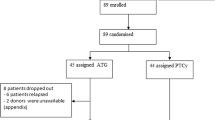Abstract
Background
As a reduced-intensity stem-cell transplantation (RIST) regimen, the combination of fludarabine and melphalan (FM) with an appropriate immunosuppressant reduces nonrelapse mortality (NRM).
Methods
We retrospectively compared the efficacy of a RIST regimen with FM with that of a conventional stem cell transplantation (CST) regimen. Eighty-two consecutive hematological patients who underwent allogeneic stem-cell transplantation (SCT) at our hospital were enrolled. Preparation for RIST consisted of 25 mg/m2 fludarabine and melphalan 70 mg/m2. The conventional regimen employed high-dose cyclophosphamide and total-body irradiation (12 Gy) or busulfan and high-dose cyclophosphamide. Graft-versus-host disease (GVHD) prophylaxis for RIST consisted of tacrolimus alone or in conjunction with short-term methotrexate for unrelated donors.
Results
Of the 82 patients, 42 received the conventional CST regimen (median age, 35 years) and 40 received the RIST regimen (median age, 51 years). The probability of NRM was 17% (7/42) in the CST group and 8% (3/40) in the RIST group. Grade II to IV GVHD occurred in significantly more CST patients (38%) than RIST patients (28%). However, the overall survival was the same in the two groups (43%).
Conclusion
The RIST regimen with FM incorporating tacrolimus and methotrexate demonstrated low TRM incidence and moderate control of GVHD and had efficacy comparable to that of the CST regimen, despite the advanced age of the RIST patient group.
Similar content being viewed by others
References
Thomas ED (1983) Karnofsky Memorial Lecture. Marrow transplantation for malignant diseases. J Clin Oncol 1:517–531
Satwani P, Harrison L, Morris E, et al. (2005) Reduced-intensity allogeneic stem cell transplantation in adults and children with malignant and nonmalignant diseases: end of the beginning and future challenges. Biol Blood Marrow Transplant 11:403–422
Kassim AA, Chinratanalab W, Ferrara JL, Mineishi S (2005) Reduced-intensity allogeneic hematopoietic stem cell transplantation for acute leukemias: “what is the best recipe?”. Bone Marrow Transplant 36:565–574
Chakraverty R, Peggs K, Chopra R, et al. (2002) Limiting transplantation-related mortality following unrelated donor stem cell transplantation by using a nonmyeloablative conditioning regimen. Blood 99:1071–1078
Giralt S, Estey E, Albitar M, et al. (1997) Engraftment of allogeneic hematopoietic progenitor cells with purine analog-containing chemotherapy: harnessing graft-versus-leukemia without myeloablative therapy. Blood 89:4531–4536
Giralt S, Thall PF, Khouri I, et al. (2001) Melphalan and purine analog-containing preparative regimens: reduced-intensity conditioning for patients with hematologic malignancies undergoing allogeneic progenitor cell transplantation. Blood 97:631–637
de Lima M, Anagnostopoulos A, Munsell M, et al. (2004) Nonablative versus reduced-intensity conditioning regimens in the treatment of acute myeloid leukemia and high-risk myelodysplastic syndrome: dose is relevant for long-term disease control after allogeneic hematopoietic stem cell transplantation. Blood 104: 865–872
Hill GR, Ferrara JL (2000) The primacy of the gastrointestinal tract as a target organ of acute graft-versus-host disease: rationale for the use of cytokine shields in allogeneic bone marrow transplantation. Blood 95:2754–2759
Mielcarek M, Martin PJ, Leisenring W, et al. (2003) Graft-versushost disease after nonmyeloablative versus conventional hematopoietic stem cell transplantation. Blood 102:756–762
Couriel DR, Saliba RM, Giralt S, et al. (2004) Acute and chronic graft-versus-host disease after ablative and nonmyeloablative conditioning for allogeneic hematopoietic transplantation. Biol Blood Marrow Transplant 10:178–185
Sandmaier BM, Mackinnon S, Childs RW (2007) Reduced intensity conditioning for allogeneic hematopoietic cell transplantation: current perspectives. Biol Blood Marrow Transplant 13(1 Suppl 1):87–97
Tauro S, Craddock C, Peggs K, et al. (2005) Allogeneic stem-cell transplantation using a reduced-intensity conditioning regimen has the capacity to produce durable remissions and long-term disease-free survival in patients with high-risk acute myeloid leukemia and myelodysplasia. J Clin Oncol 23:9387–9393
Inamoto Y, Oba T, Miyamura K, et al. (2006) Stable engraftment after a conditioning regimen with fludarabine and melphalan for bone marrow transplantation from an unrelated donor. Int J Hematol 83:356–362
Yanada M, Emi N, Naoe T, et al. (2004) Tacrolimus instead of cyclosporine used for prophylaxis against graft-versus-host disease improves outcome after hematopoietic stem cell transplantation from unrelated donors, but not from HLA-identical sibling donors: a nationwide survey conducted in Japan. Bone Marrow Transplant 34:331–337
Author information
Authors and Affiliations
Corresponding author
About this article
Cite this article
Imataki, O., Ohnishi, H., Ohbayashi, Y. et al. Fludarabine and melphalan conditioning with tacrolimus as GVHD prophylaxis for allogeneic stem cell transplant recipients is an effective reduced-intensity combination regimen compared to the conventional regimen. Int J Clin Oncol 14, 197–201 (2009). https://doi.org/10.1007/s10147-008-0826-7
Received:
Accepted:
Published:
Issue Date:
DOI: https://doi.org/10.1007/s10147-008-0826-7




